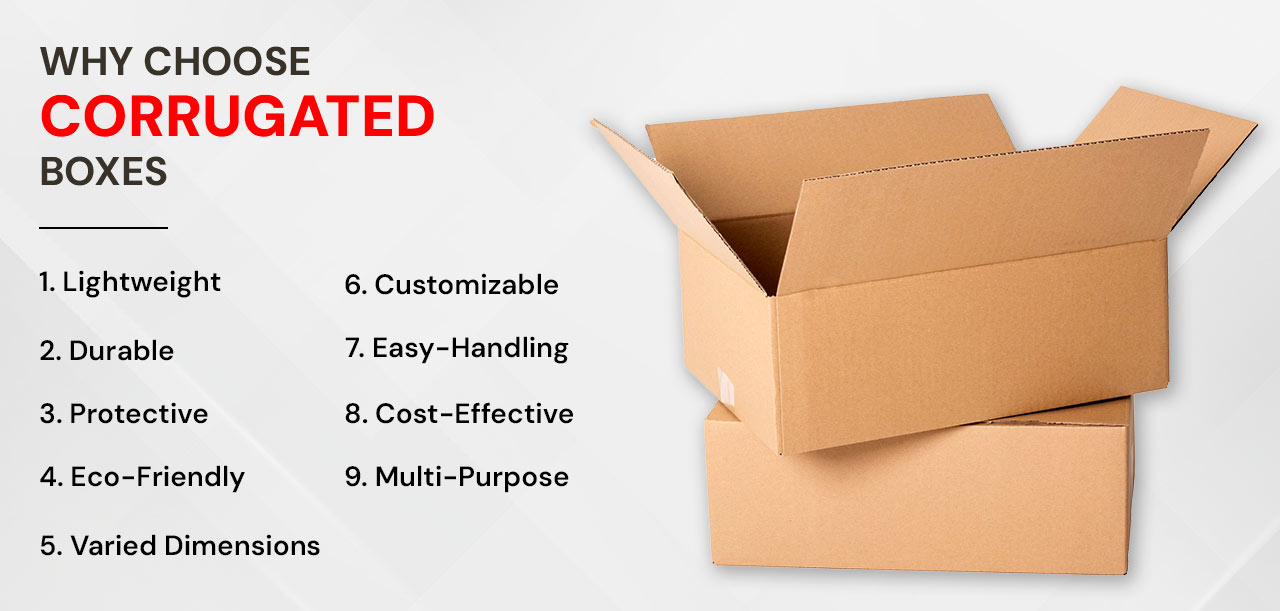If you have been considering the right packaging option to invest in for your business, we’ve got answers.
Whether you’re a retail, F&B, fashion and lifestyle, electronics, industrial goods, or an e-Commerce business, packaging is essential to customer experience and service. So, what materials do businesses generally use for packaging? Why is the corrugated box so popular? And why should you consider using corrugated boxes for your packaging?
This article is your guide to all of these answers and more! Let’s get started.
Popular Packaging Options

Among the most popular packaging options businesses use besides paper or corrugated material are plastic, wood, glass, steel, and aluminum. Let’s delve further into each.
Plastic Packaging
The most well-known packaging material, plastic, is highly flexible, durable, and lightweight. Moreover, it can also be safe for food, opaque or transparent, and resistant to chemicals and heat.
The biggest disadvantage of plastic is its recyclability. Statistica recorded that humans produce more than 350 million metric tonnes of plastic waste yearly. And only 9% is ever recycled, according to National Geographic.
Wooden Packaging
Found across the F&B, grocery, automotive, and construction industries, wooden packaging is among the most environmentally friendly solutions thanks to its reusability.
What’s the drawback? Being a natural material makes it more susceptible to pests and insect damage than materials like plastic, glass, or metal.
Glass
Packaging Outlook shows that 90% of people in 2017 preferred liquids, including wine and beer, in glass packaging. Many medicinal supplies are also safer in glass.
Glass is quite popular in the F&B sector thanks to its non-porous and non-toxic properties. Plus, it’s 100% recyclable.
So, what’s the downside of using glass for packaging? Besides its breakability during transit, glass requires a lot of heat and energy for manufacturing, making its carbon footprint and production costs relatively high.
Steel
Steel containers are commonly used for shipping industrial manufacturing items and are highly durable and resistant to rough handling, weather conditions, and heavy loads. It is also recyclable and reusable.
The downside of steel, like most metals, is corrosion and opaqueness. But unlike other metals, steel is mostly chemically inert and safe for food.
Aluminum
Aluminum packaging includes aluminum cans, foil, and aerosol products. The material protects against light, ultraviolet rays, oils, and oxygen and is usually used for packaging food or medications.
Paper and Paperboard
The first thing that usually comes to mind when you think of packaging is a corrugated box.
Corrugated box manufacturers ensure these boxes are structurally stable for shipping, storing, and marketing products. In addition, they are recyclable, renewable, and frequently reusable. They’re also easily stackable.
Although cost-effective, lightweight, and flexible, corrugated boxes pose one disadvantage, depending on what you need to store or ship. They may not be as sturdy as some other packaging materials.
Fun Fact
We know that corrugated boxes are widespread, especially in the eCommerce sector. But did you know that over 95% of products in the US are shipped in corrugated boxes? The Fibre Box Association reported this interesting statistic.
Now that we’ve glimpsed through the different materials used for packaging and their pros and cons, let’s talk about why corrugated boxes are preferred for use.
9 Convincing Reasons to Choose Corrugated Boxes

- They’re lightweight, so they’re easy to ship.
- They’re durable. Their fluted layers make them sturdy and protective against impacts, reducing the chances of product damage.
- They can protect items (within them) against impact damage.
- Corrugated box manufacturers make boxes from paper and mainly recycled material, making these boxes eco-friendly.
- You can select from different box sizes and shapes according to your packaging needs.
- The lightweight feature of corrugated boxes makes them easy to handle thereby simplifying the shipping, storage, and distribution process.
- When you purchase from corrugated box companies (like Sewing Collection Inc.) in bulk, you save significantly. When you ship packages in corrugated boxes, their light weight means lesser costs. Corrugated box manufacturers, too, require relatively less costs and resources than other packaging materials. Thus, all in all, corrugated boxes are quite cost-effective.
- Need a specific size? A specific shape? Branding on your boxes? These boxes are highly customizable and easy to print on.
- Lastly, besides being such an excellent option for shipping, corrugated boxes are multi-purpose. You can also use them for storing and retail brand packaging.
Convinced enough? If you’re still wondering which corrugated boxes would suit your needs the best, here’s a gist of the options we provide at SCI:
Types of Corrugated Boxes at SCI
Garment Boxes
- Accommodates larger items with its spaciousness.
- Accessible with opening along the length.
200 lb Boxes
- Strong with 200 lb weight capacity.
- Durable with C-flute corrugated material.
- Versatile for various applications.
Heavy-Duty Boxes
- Protective with 44 ECT for added protection.
- Durable and reliable with sturdy material and construction.
Double-Wall Boxes
- Provides extra strength with a sturdy double-wall construction.
- Durable with 200# DW corrugated material.
Mailer Boxes
- Sturdy, custom-made with double-wall sides and triple-wall front construction.
- Space-saving with flat shipping.
- Protective with 32 ECT B-Flute Kraft.
Die Cut Boxes
- Custom-fit boxes for your requirements.
- Space-saving.
- Protective with double padding.
Conclusion
Corrugated boxes are an excellent choice for most packaging needs. You can pack almost anything from fabrics, footwear, stationery, and art to electronics, home appliances, decor, food and beverages, and industrial equipment.
Corrugated boxes may not be ideal if you’re looking for packaging solutions for perishable goods like fresh produce, frozen food, or products that require temperature and humidity control. They may also not be ideal for packing hazardous materials like chemicals and explosives, hefty items like automotive parts, liquids, and semi-liquids, or high-value items like rare collectibles or jewelry that may need additional security measures.

